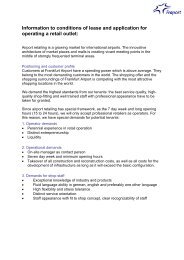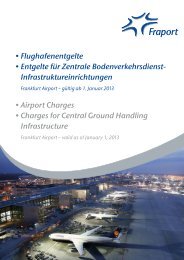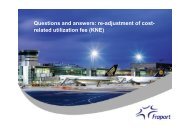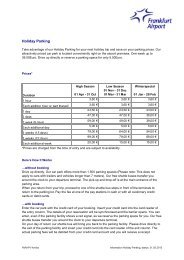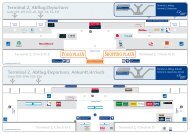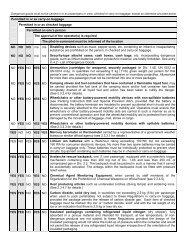Dangerous Goods Regulations, 54th Edition 2013 ... - Frankfurt Airport
Dangerous Goods Regulations, 54th Edition 2013 ... - Frankfurt Airport
Dangerous Goods Regulations, 54th Edition 2013 ... - Frankfurt Airport
You also want an ePaper? Increase the reach of your titles
YUMPU automatically turns print PDFs into web optimized ePapers that Google loves.
2<br />
2.3<br />
Permitted in or as carry-on baggage<br />
NO<br />
YES<br />
YES<br />
YES<br />
YES<br />
YES<br />
YES<br />
YES<br />
Permitted in or as checked<br />
NO<br />
YES<br />
NO<br />
NO<br />
YES<br />
YES<br />
YES<br />
YES<br />
<strong>Dangerous</strong> <strong>Goods</strong> <strong>Regulations</strong> (AM1)<br />
TABLE 2.3.A<br />
Provisions for <strong>Dangerous</strong> <strong>Goods</strong> Carried by Passengers or Crew<br />
(Subsection 2.3)<br />
<strong>Dangerous</strong> goods must not be carried in or as passengers or crew, checked or carry-on baggage, except as otherwise<br />
provided below.<br />
Permitted on one's person<br />
NO<br />
YES<br />
YES<br />
NO<br />
NO<br />
NO<br />
NO<br />
NO<br />
The approval of the operator(s) is required<br />
n/a<br />
YES<br />
YES<br />
YES<br />
YES<br />
YES<br />
YES<br />
YES<br />
The must be informed of the<br />
n/a<br />
NO<br />
NO<br />
YES<br />
Disabling devices such as mace, pepper spray, etc. containing an irritant or<br />
substance are forbidden on the person, in checked and carry-on<br />
Electro shock weapons (e.g. Tasers) containing dangerous goods such as<br />
compressed gases, lithium batteries, etc. are forbidden in carry-on baggage or checked<br />
or on the<br />
attaché cases, cash boxes, cash bags, etc. incorporating dangerous goods,<br />
such as lithium batteries and/or pyrotechnic material, except as provided in 2.3.2.6 are<br />
forbidden. See entry in 4.2 - List of <strong>Dangerous</strong><br />
Ammunition (cartridges for weapons), securely packaged (in Div. 1.4S, UN 0012<br />
UN 0014 only), in quantities not exceeding 5 kg gross weight per person for that person's<br />
use. Allowances for more than one person must not be combined into one or more<br />
wheelchairs or other similar mobility devices with non-spillable<br />
batteries or with batteries which comply with Special Provision A123, (see<br />
wheelchairs or other similar mobility devices with spillable batteries<br />
with lithium batteries (see 2.3.2.3 and 2.3.2.4 for<br />
mobility aids with lithium ion batteries (collapsible), lithium-ion<br />
must be removed and carried in the cabin (see 2.3.2.4(d) for<br />
Camping stoves and fuel containers that have contained a flammable liquid fuel,<br />
empty fuel tank and/or fuel container (see 2.3.2.5 for<br />
Security-type equipment containing lithium batteries (see 2.3.2.6 for<br />
Lithium ion battery powered equipment containing batteries over 100 Wh but not exceeding<br />
160<br />
Spare lithium ion batteries with a Watt-hour rating exceeding 100 Wh but not exceeding<br />
160 Wh for consumer electronic devices. Maximum of two spare batteries may be carried in<br />
carry-on baggage only. These batteries must be individually protected to prevent short<br />
Mercury barometer or thermometer carried by a of a government weather<br />
bureau or similar official agency (see 2.3.3.1 for<br />
Avalanche rescue backpack, one (1) per person, containing a cylinder of compressed gas in<br />
Div. 2.2. May also be equipped with a pyrotechnic trigger mechanism containing less<br />
200 mg net of Div. 1.4S. The backpack must be packed in such a manner that it cannot<br />
accidentally activated. The airbags within the backpacks must be fitted with pressure relief<br />
valves.<br />
Carbon dioxide, solid (dry ice), in quantities not exceeding 2.5 kg per person when used<br />
pack perishables not subject to these <strong>Regulations</strong> in checked or carry-on baggage, provided the<br />
baggage (package) permits the release of carbon dioxide gas. Checked baggage must<br />
marked “dry ice” or “carbon dioxide, solid” and with the net weight of dry ice or an indication that<br />
there is 2.5 kg or less dry<br />
Chemical Agent Monitoring Equipment, when carried by staff members of the Organization for<br />
the Prohibition of Chemical Weapons on official travel (see<br />
Heat producing articles such as underwater torches (diving lamps) and soldering irons.<br />
(See 2.3.4.6 for<br />
Oxygen or air, gaseous, cylinders required for medical use. The cylinder must not exceed 5 kg<br />
gross<br />
Note: Liquid oxygen systems are forbidden for<br />
Portable medical electronic devices (Automated External Defibrillators (AED),<br />
Continuous Positive Airway Pressure (CPAP), etc.) containing lithium metal or lithium ion cells or<br />
batteries may be carried (see 2.3.4.7 for details).<br />
24 <strong>54th</strong> EDITION, 1 JANUARY <strong>2013</strong>
Permitted in or as carry-on baggage<br />
Permitted in or as checked<br />
Permitted on one's person<br />
The approval of the operator(s) is<br />
The must be informed of the location<br />
YES YES YES YES NO Small gas cylinders, containing carbon dioxide or other suitable gas in Division<br />
2.2. Up to two (2) small cylinders fitted into a life jacket, and up to two (2) spare cartridges per<br />
person, not more than four (4) cylinders up to 50 mL water capacity for other<br />
YES<br />
NO<br />
YES<br />
NO<br />
NO<br />
YES<br />
NO<br />
YES<br />
YES<br />
YES<br />
YES<br />
NO<br />
NO<br />
NO<br />
NO<br />
NO<br />
NO<br />
NO<br />
NO<br />
NO<br />
NO<br />
NO<br />
Note:<br />
n/a means not applicable<br />
TABLE 2.3.A<br />
Provisions for <strong>Dangerous</strong> <strong>Goods</strong> Carried by Passengers or Crew<br />
(Subsection 2.3) (continued)<br />
NO<br />
NO<br />
NO<br />
NO<br />
NO<br />
NO<br />
NO<br />
NO<br />
NO<br />
NO<br />
NO<br />
Alcoholic beverages, when in retail packagings, containing more than 24% but not more<br />
than 70% alcohol by volume, in receptacles not exceeding 5 L, with a total net quantity<br />
person of 5<br />
Aerosols in Division 2.2, with no subsidiary risk, for sporting or home use.<br />
medicinal or toilet articles (including aerosols) such as hair<br />
perfumes, colognes and medicines containing alcohol.<br />
The total net quantity of all above mentioned articles must not exceed 2 kg or 2 L, and the net<br />
quantity of each single article must not exceed 0.5 kg or 0.5 L. Release valves on aerosols must<br />
be protected by a cap or other suitable means to prevent inadvertent release of the contents.<br />
Energy efficient light bulbs when in retail packaging intended for personal or home use.<br />
Fuel cells, and spare fuel cartridges powering portable electronic devices (e.g.<br />
cellular phones, laptop computers, and camcorders), see 2.3.5.10 for details.<br />
Hair curlers containing hydrocarbon gas, up to one (1) per passenger or<br />
provided that the safety cover is securely fitted over the heating element. These hair curlers<br />
must not be used on board the aircraft at any time. Gas refills for such curlers are not permitted<br />
in checked or carry-on baggage.<br />
Insulated packagings containing refrigerated liquid nitrogen (dry shipper), fully absorbed in<br />
a porous material containing only goods.<br />
Internal combustion or fuel cell engines, must meet A70 (see 2.3.5.15 for details).<br />
Medical or clinical thermometer, which contains mercury, one (1) per person for personal<br />
when in its protective case.<br />
non-toxic gas cylinders worn for the operation of mechanical limbs.<br />
spare cylinders of a similar size if required to ensure an adequate supply for the duration of the<br />
journey.<br />
specimens packed with small quantities of flammable liquid, must meet A180<br />
(see 2.3.5.14 for details).<br />
Permeation devices, must meet A41 (see 2.3.5.16 for details).<br />
Limitations<br />
Portable electronic devices containing lithium metal or lithium ion cells or batteries, such<br />
as watches, calculating machines, cameras, cellular phones, lap-top computers,<br />
etc., when carried by passengers or crew for personal<br />
All spare batteries, including lithium metal or lithium ion cells or batteries, for such<br />
portable electronic devices must be carried in carry-on baggage only. These batteries must<br />
individually protected to prevent short circuits.<br />
Portable electronic devices containing non-spillable batteries, batteries must meet A67<br />
must be 12 V or less and 100 Wh or less. A maximum of 2 spare batteries may be carried (see<br />
2.3.5.13 for<br />
cardiac pacemakers or other devices, including those powered by lithium<br />
batteries, implanted into a person, or contained within the body of a<br />
as the result of medical<br />
Safety matches (one small packet) or a cigarette lighter that does not contain unabsorbed<br />
liquid fuel, other than liquefied gas, intended for use by an individual when carried on the<br />
Lighter fuel and lighter refills are not permitted on one's person or in checked<br />
carry-on<br />
Note: “Strike anywhere” matches, “Blue flame” or “Cigar” lighters are forbidden.<br />
<strong>54th</strong> EDITION, 1 JANUARY <strong>2013</strong> 25<br />
2<br />
2.3



